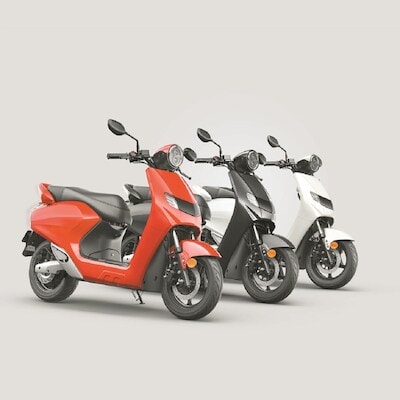In the second year, the price will be halved to Rs 2,500 per kilowatt hour, with the total benefit not exceeding Rs 5,000. | Representative photo
Buyers of electric two-wheelers can avail a maximum subsidy of up to Rs 10,000 in the first year of the PM E-DRIVE scheme that will be implemented soon, Union Heavy Industries Minister HD Kumaraswamy said on Thursday.
Addressing a press conference, Kumaraswamy said the subsidy under the PM E-DRIVE Scheme for electric two-wheelers has been fixed based on battery power at Rs 5,000 per kilowatt hour, but the overall incentive will not exceed Rs 10,000 in the first year.
In the second year, the rate will be halved to Rs 2,500 per kilowatt hour, with the total benefit not exceeding Rs 5,000.
Addressing the media, Kumaraswamy said that e-rickshaw buyers can avail the benefits of Rs 25,000 subsidy in the first year and Rs 12,500 in the second year under the PM E-DRIVE scheme.
“The per kilowatt subsidy for electric two-wheelers is Rs 5,000 for the first year and Rs 2,500 in the second year. For two years, this benefit will continue,” the minister said.
He clarified that the maximum benefit per two-wheeler will be capped at Rs 10,000 per vehicle in the first year and will be reduced to Rs 5,000 in the second year.
Currently, popular electric scooters from manufacturers such as Ola, TVS, Ather Energy, Hero Vida (Hero Motocorp) and Chetak Bajaj have battery capacities ranging from 2.88 kWh to 4 kWh in a price range of Rs 90,000 to Rs 1.5 lakh.
For three-wheelers, including e-rickshaws, Kumaraswamy said, “In the first year, they will get a benefit of Rs 25,000, and in the second year, it will be reduced to Rs 12,500 per vehicle.”
For L5 category (three-wheeled cargo vehicles), they will get a benefit of Rs 50,000 in the first year, and for the second year, it will be Rs 25,000, the minister further informed.
Under the scheme, the PM E-DRIVE portal will issue an Aadhaar-authenticated e-receipt, which will need to be duly signed by the buyer and the dealer and uploaded on the portal. The buyer will also need to upload a selfie to avail demand incentives under the scheme.
To prevent misuse of government subsidies in the scheme, MHI Secretary Kamran Rizvi said, “We have learnt a lot from FAME-II. So, every six months there will be a conformity of production test, which will ensure that everything is tested twice a year.”
Asked if EV makers who have allegedly flouted FAME II norms would be excluded from PM E-DRIVE, Kumaraswamy said, “How can we encourage them? We will take a decision.”
Kumaraswamy informed that demand side subsidies/incentives worth Rs 3,679 crore have been provided to incentivise electric two-wheelers, three-wheelers, electric ambulances, electric trucks and other emerging electric vehicles under the PM E-DRIVE scheme. The scheme will support 24.79 lakh electric two-wheelers, 3.16 lakh electric three-wheelers and 14,028 electric buses.
The scheme has allocated Rs 500 crore for deployment of e-ambulances to promote their use for comfortable transportation of patients.
The performance and safety standards of electric ambulances will be formulated in consultation with the Ministry of Health and Family Welfare, Ministry of Road Transport and Highways and other relevant stakeholders, the minister said.
Commenting on the level of EV penetration envisaged under the new plan, Rizvi said the government expects 10 per cent of new annual sales to be electric two-wheelers and 15 per cent of new annual sales to be three-wheelers.
Asked about the reasons for excluding electric passenger vehicles used for commercial purposes from the scheme, Kumaraswamy said they currently attract only 5 per cent GST, as opposed to 28 per cent plus cess for internal combustion engine vehicles.
On the Payment Security Mechanism (PSM) of PM-eBus Sewa, Rizvi said the government has ensured payments to electric bus operators with 38,000 electric buses with an outlay of over Rs 3,435 crore.
“If a city has contracted a particular operator to operate its buses and the operator does not get paid on time, then we will make the payment through PSM. A period of three months is given (to the state to make the payment). Within that period, the state has to return the money… then (if payment is not made) there is a provision under which the RBI can debit the (state) government’s account.”
He said that under the PSM, payments will be guaranteed for 12 years.
He further said that only those states which have signed this mandate will get the PM E-BUS SEVA scheme.
“We are aware of 15 such states so far,” he said.
(Only the headline and image of this report may have been reworked by Business Standard staff; the rest of the content is auto-generated from a syndicated feed.)
First published: September 12, 2024 | 11:10 PM IS
Disclaimer:
The information contained in this post is for general information purposes only. We make no representations or warranties of any kind, express or implied, about the completeness, accuracy, reliability, suitability or availability with respect to the website or the information, products, services, or related graphics contained on the post for any purpose.
We respect the intellectual property rights of content creators. If you are the owner of any material featured on our website and have concerns about its use, please contact us. We are committed to addressing any copyright issues promptly and will remove any material within 2 days of receiving a request from the rightful owner.

